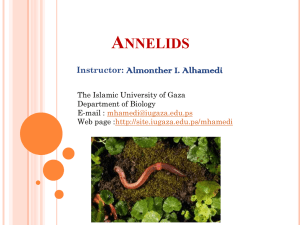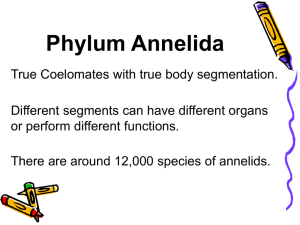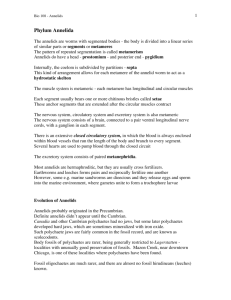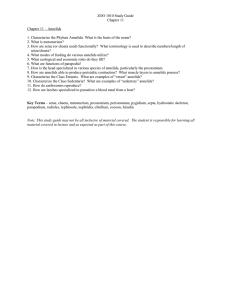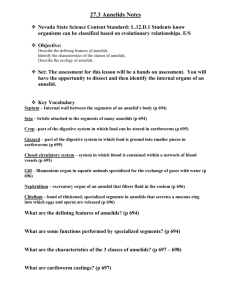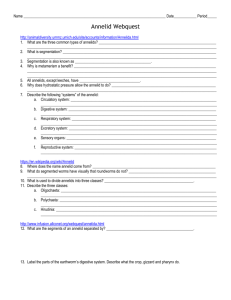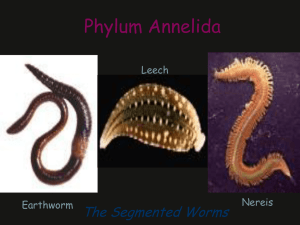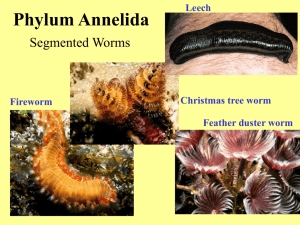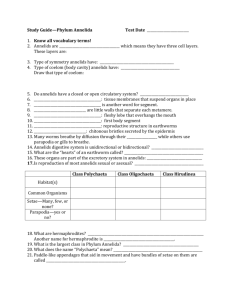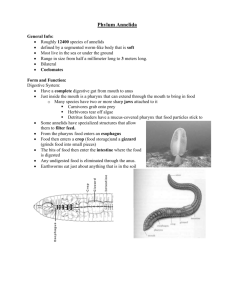Annelids – Part 1
advertisement
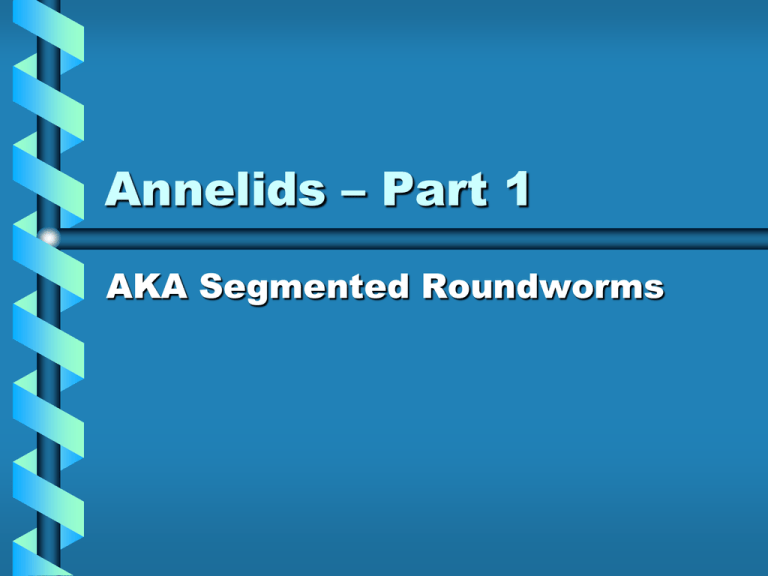
Annelids – Part 1 AKA Segmented Roundworms Annelids • The word annelid is derived from the word annulus which means ring. – In this way, annelids get their name from their most defining characteristic – their external and internal segments, or rings. Classes of Annelids • Annelids have three main classes based on habitat and differences in body structure. • They are: – Polychaete (paul-ee-keet) – Oligochaete (awl-ee-go-keet) – Hirudinea (hir-oo-din-ee-uh) Polychaete Worms • AKA clamworms • Size: millimeters to meters long • Change in body structure: has many bristles. • Habitat: marine environment • Types of movement: sedentary or mobile Mobile Polychaete • Mobile worms: • Tend to swim around and catch food • Have parapodia (little flaps of skin that act as legs) for movement. • Parapodia have setae (bristles) and cirri (needle-like projections) on them. • Have eyes, sensory tentacles, and a retractable pharynx with jaws. – Ex. Nereis virens Sedentary Polychaete • Sedentary Worms • Tend to burrow in sand or mud & filter feed. • They suck up sand or mud and selectively absorb nutrients. • Often lack eyes and have much smaller parapodia. • Some secrete their own tube to burrow into. • Ex. Arenicola Oligochaete Worms • Change in body structure: few bristles. • Habitat: damp terrestrial environments • Best known oligochaete is the earthworm Earthworm • The earthworm is mostly nocturnal and tends to live in underground tunnels. • They help to develop and add nutrients to the soil. • They are considered to be more advanced than polychaete. Hirudinea • Change in body structure: flattened body, with no parapodia or bristles. • Habitat: freshwater or terrestrial parasites or predators. – They attach to their prey by suckers. • Ex. Leeches – After having it’s fill of a victims blood they can go for weeks or months without eating. Annelid Body Structure • Bilateral symmetry • Coelomates: have a lined coelom (body cavity). – This is an advancement over nematodes. • Cuticle covered body to keep the worm from drying out, while still allowing movement. Digestive System • More advanced than the nematodes. • One way system, in addition to the nematode parts they have: – Calciferous glands • Monitor acid-base levels of the coelomic and blood fluids. – Crop • Used to store food. – Gizzard • Food is ground into digestible pieces. Mouth buccal cavity pharynx esophagus (attached to calciferous glands) crop gizzard intestine anus Nervous System • Anterior brain with paired ventral nerve cords. – Has peripheral nerves that supply the muscle layers and reach the sense receptors of the outer wall. • Also have ganglia that allow for movement. • Each segment has a nerve cord that passes through a ganglia and attaches to sense receptors. – This nerve cord consists of giant nerve fibers and is responsible for coordinating movement of all the segments. Muscular System • Both longitudinal and circular muscles – another advancement over nematodes. • Seta retractors are muscles that connect from one set of setae to another. This allows for coordinated movement. – Remember, setae are bundles of bristles. Circulatory System • We haven’t seen one of these since the piggy! • Two kinds are seen in annelids: – Open: no vessels, blood empties into sinuses, or cavitites. (in the leech) – Closed: has vessels to hold and direct blood. (in the clamworm & earthworm) Reproduction • Annelids are hermaphroditic. • They reproduce sexually. Excretory System The excretory system is called a metanepridium. – Each segment has a funnel like nephrostome which is covered by tiny hair-like structures (cilia) leading into the coelom of that segment. – The segments are connected together by a convuluted tubule which leads from the nephrostome into the bladder of another segment. – Wastes are excreted through the nephridiopore. A note on leeches • Leeches are sometimes considered to be parasitic organisms. • However, their relationship with the host is relatively brief, so it is more correct to classify them as predatory. – #13 on page 99 in your resource book incorrectly states that they are not freeliving, but rather are considered to be a parasitic organism. Annelid Importance • Annelids are important to humans for the following reasons: – Earthworms help to add nutrients to our soil. – Leeches are used medicinally to help promote blood flow to areas. – They make good bait for fishing!!
